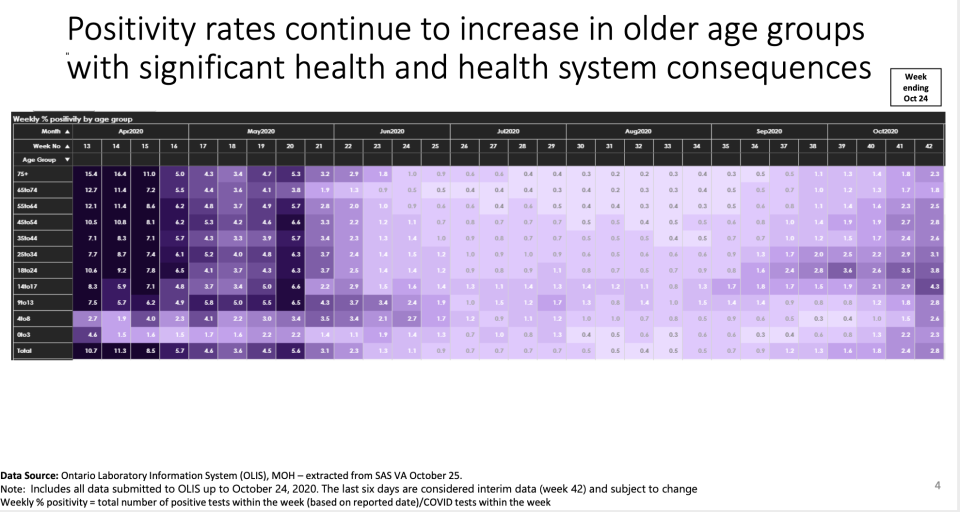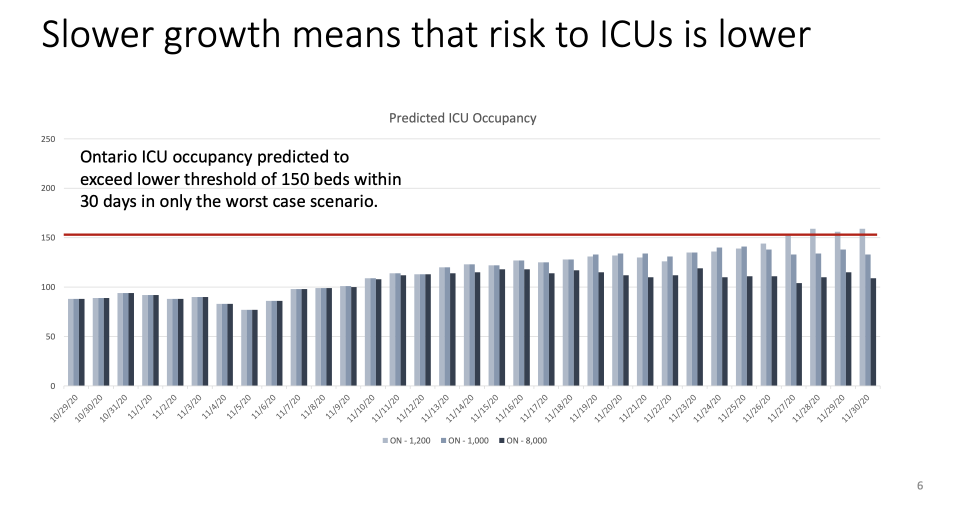COVID-19 in Canada: Ontario coronavirus models reveal cases growth is much 'slower' than anticipated; Alberta changing testing guidelines for children
For more on today’s top stories and the spread of the novel coronavirus across the country, please refer to our live updates below throughout the day, as well as our COVID-19 news hub.
Ontario cases not declining, but they aren’t on ‘as steep of a curve’ either

Ontario’s latest modelling data shows that COVID-19 growth is “much slower” than previous anticipated, but the numbers are still increasing.
Dr. Adalsteinn Brown, co-chair of the Ontario COVID-19 Science Advisory Table, said the province is much closer to the Michigan scenario than the “worst case” scenario.
“Although cases are continuing to grow, that growth has slowed and we’re starting to see a more gentle curve,” he said.

There is “substantial variation” in COVID-19 cases per 100,000 population by public health units in Ontario.
It varies from Peel at 83.1, to Halton at 30.7 and the “other” public health units, not called out on the graph, all below 13.

There has been an increase in the positivity rate in older age groups, which Dr. Brown indicated may reflect some of the interventions put in place but also “creates a bit of a warning signal because it is in the older age population where we see the biggest heath and health system consequences.”

Over the past three weeks, there has been a 56 per cent increase in COVID-19 bed occupancy at Ontario hospitals.
Officials maintain that the growth is still slower than previous forecasts but is still cause for concern.

The same was said about ICU growth, with the latest data showing that only the worst case scenario would see the 150 bed threshold exceeded.

Dr. Brown highlighted that Ontario has seen a “much sharper growth in cases” in long-term care facilities. Reported deaths are taking a much sharper increase as well.

There is also significant variation in where outbreaks are occurring in Ontario.
“There’s not one consistent pattern but it’s important to look at where outbreaks are happening... to understand especially where you can put interventions,” Dr. Brown said.
When asked about why restrictions were added to restaurants and bars when they seemingly only make up a limited number of outbreaks, Dr. David Williams, Ontario’s chief medical officer of health, said “risk sites” where people are indoors and unable to wear a mask for a long period of time were identified.
Dr. Brown explained that outbreaks are not the only way cases are seen, but it also impacts the risk factors of community spread.
“What we’re seeing here is what outbreaks have been reported and what outbreaks have been identified during that period of time,” Dr. Dirk Huyer, coordinator of the provincial outbreak response said. “This is all back to prevention.”
“It’s about the social setting and the infectivity of this virus that is so easily transmitted from person to person without people necessarily recognizing.”
Dr. William went on to defend himself by saying the recommendations to add restrictions to restaurants in modified Stage 2 areas was not political.
“My recommendations are based on science and evidence,” he said, adding that federal modellers have also demonstrated higher risks when people are in these congregate settings.
“We are seeing continued growth in cases,” Dr. Huyer said. “We are not going on a decline right now but we are not going on as steep of a curve...we are still seeing growth, we are still seeing people sick in the hospital, we are still seeing people in the intensive care unit.”
“We still have seen a number of people dying and in long-term care that death rate has increased. There is some slowing of that growth, which is so important because it speaks to the efforts that everybody is making.”
Ontario’s ‘surgical approach’ to COVID-19 restrictions
During an announcement in Barrie, Ont., premier Doug Ford said he’s continuing to work with local healthcare teams to take a more “surgical” approach to public health measures and restrictions in different areas of the province.
He did not reveal if modified Stage 2 restrictions would be extended in Toronto, Peel, Ottawa or York but said the province is seeing “a little bit of a decline.”
“But make no mistake about it, please do not let your guard down, we can’t,” Ford said.
The premier added he “can’t stand” closing any businesses and doesn’t want to “paint a broad brush across any industry,” including gyms and restaurants.
“We’ve got to help these people out,” Ford said.
Focus on Ontario-made products
The Ontario government also announced the Canadian Manufacturers and Exporters is launching a new Ontario Made Consumer Directory to help shoppers to find made-in-Ontario products.
“As local manufacturers have proven time and time again during this pandemic, they can make anything. Ontario-made products are second to none in quality and excellence,” Ford said in a statement. “That's why I'm proud to support this new CME campaign to encourage Ontarians to look for the 'Ontario Made' label when shopping.”
“Our manufacturers were there for us during the pandemic, whether it was making PPE or keeping supply chains strong. Let's all support them in turn and shop local.”
Alberta changes guidance for screening children for COVID-19
Dr. Deena Hinshaw, Alberta's chief medical officer of health, announced that beginning on Monday, symptom screening information for people under the age of 18 will change, including the daily checklist in all childcare settings.
The first change is the removal of runny nose and sore throat from the list of symptoms that require mandatory isolation of children.
In the last week, more than 3,400 children were tested for COVID-19 with a sore throat. Of those, approximately 700 had sore throat as their only symptom and less than one percent had a positive test.
More than 3,300 children were tested for COVID-19 with a runny nose. Of those, 601 had a runny nose as their only symptom. Less than 0.5 per cent of those children tested positive for COVID-19.
“This shows us that these symptoms, by themselves, are very poor indicators of whether a child has the virus,” Dr. Hinshaw said. “Based on our data so far, the risk that a child with just on of these symptoms have COVID is even lower if that child is not known to be a close contact of someone with COVID-19.”
Alberta’s chief medical officer of health said this change is only relevant for those who have not had a known exposure in the last 14 days.
The province is also shifting to “a more targeted checklist” that takes into account the total number of symptoms a child has.
“Any child who has even one of the core isolation symptoms, which are cough, fever, shortness of breath, and a new core isolation symptom of loss of taste or smell, must still isolate for 10 days or have a negative test result, and resolved symptoms, before resuming activities,” Dr. Hinshaw said.
But also beginning on Monday, if a child has only one of any of the other symptoms they should stay home and monitor for 24 hours.
“If their symptoms improve at 24 hours, testing is not necessary and they can return to normal activities when they feel well enough,” Dr. Hinshaw said. “If the child has two or more symptoms on the list then testing is recommended and they should stay home until the symptoms go away or they test negative for COVID-19.”
‘This is not the year for large Halloween parties’
Alberta's chief medical officer of health also spoke about Halloween, stressing to the public that “this is not the year for large Halloween parties.”
“Unfortunately, after every holiday during the pandemic we have seen a rise in the number of cases one to two weeks later,” Dr. Hinshaw said. “This weekend, I am asking Albertans as clearly and strongly as possible to please be wise and be safe.”
She asked everyone to follow the guidelines, including only trick-or-treating within your household, wearing a non-medial mask with costumes, and staying home and not handing out candy if at all ill.
CASES AND OUTBREAKS
Ontario’s daily COVID-19 cases back above 900
Ontario reported 934 new confirmed COVID-19 cases on Thursday, an increase from the 834 cases reported a day earlier.
Toronto recorded its highest number of daily cases to date at 420, with 169 additional cases in Peel, 95 in York Region and 58 in Ottawa.
Ontario confirmed 10 more COVID-19 deaths in the province, bringing the total to 3,118.
In the last 24 hours, 35,621 tests were completed and 40,074 are currently under investigation.
There are currently 322 people with COVID-19 in Ontario hospitals, including 77 in ICU.
There are 83 long-term care facilities in the province with an active COVID-19 outbreak, with 419 resident cases and 283 staff cases.
The province also reported 99 new school-related COVID-19 cases, 55 student cases, 9 staff cases and 35 have not been identified.
Quebec reports more than 1,000 new COVID-19 cases
Quebec reported 1,030 new COVID-19 cases on Thursday, the first day over 1,000 since Oct. 23, with 245 cases in Montreal, 151 cases in Montérégie, 130 in Lanaudière and 119 in Quebec City.
The province confirmed 25 more COVID-19 deaths, including eight that occurred in the last 24 hours.
There are now 509 people in Quebec hospitals, with 78 people in intensive care.
Check out our COVID-19 in Canada topic page for latest news, tips, health updates, cases and more.



